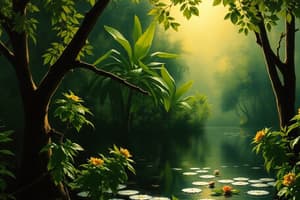Podcast
Questions and Answers
What is the primary function of photosynthesis?
What is the primary function of photosynthesis?
- Split water molecules
- Produce oxygen
- Produce glucose (correct)
- Generate ATP
What is the site of photosynthesis in a plant cell?
What is the site of photosynthesis in a plant cell?
- Nucleus
- Mitochondria
- Chloroplast (correct)
- Endoplasmic reticulum
Which factor does NOT determine the rate of photosynthesis?
Which factor does NOT determine the rate of photosynthesis?
- Water availability (correct)
- Carbon dioxide concentration
- Temperature
- Light intensity
What is the function of grana in chloroplasts?
What is the function of grana in chloroplasts?
What is produced during the light-dependent stage of photosynthesis?
What is produced during the light-dependent stage of photosynthesis?
What is the role of photophosphorylation in photosynthesis?
What is the role of photophosphorylation in photosynthesis?
What happens to the light-independent reaction if CO2 concentration is in short supply?
What happens to the light-independent reaction if CO2 concentration is in short supply?
How does low temperature affect Rubisco and other molecules?
How does low temperature affect Rubisco and other molecules?
In which cellular compartment does glycolysis occur?
In which cellular compartment does glycolysis occur?
What is the end product of glycolysis?
What is the end product of glycolysis?
Where does the Krebs cycle take place in the cell?
Where does the Krebs cycle take place in the cell?
What is produced in the Krebs cycle per glucose molecule?
What is produced in the Krebs cycle per glucose molecule?
What is the final stage of photosynthesis that uses ATP and reduced NADP to produce glucose?
What is the final stage of photosynthesis that uses ATP and reduced NADP to produce glucose?
Which enzyme catalyzes the reaction of combining RuBP with carbon dioxide in the Calvin cycle?
Which enzyme catalyzes the reaction of combining RuBP with carbon dioxide in the Calvin cycle?
What is the main function of reduced NADP and ATP in the light-independent reaction of photosynthesis?
What is the main function of reduced NADP and ATP in the light-independent reaction of photosynthesis?
Which of the following factors is considered a limiting factor in photosynthesis?
Which of the following factors is considered a limiting factor in photosynthesis?
What happens to the levels of GP, TP, and RuBP if light intensity is low?
What happens to the levels of GP, TP, and RuBP if light intensity is low?
Which molecule is NOT produced during the light-independent reaction of photosynthesis?
Which molecule is NOT produced during the light-independent reaction of photosynthesis?
Where does oxidative phosphorylation occur in the cell?
Where does oxidative phosphorylation occur in the cell?
What is the main source of ATP production in aerobic respiration?
What is the main source of ATP production in aerobic respiration?
What happens to the concentration of hydrogen ions in the intermembrane space during oxidative phosphorylation?
What happens to the concentration of hydrogen ions in the intermembrane space during oxidative phosphorylation?
What role does ATP synthase play in oxidative phosphorylation?
What role does ATP synthase play in oxidative phosphorylation?
How are hydrogen ions moved across the inner mitochondrial membrane during oxidative phosphorylation?
How are hydrogen ions moved across the inner mitochondrial membrane during oxidative phosphorylation?
What is the function of reduced coenzymes (NADH and FADH) in oxidative phosphorylation?
What is the function of reduced coenzymes (NADH and FADH) in oxidative phosphorylation?
What acts as the final electron acceptor in the process of producing water?
What acts as the final electron acceptor in the process of producing water?
Why is the theoretical yield of 38 ATP molecules per glucose rarely achieved in real life?
Why is the theoretical yield of 38 ATP molecules per glucose rarely achieved in real life?
Which molecule made during glycolysis in the cytoplasm needs to move into the matrix by active transport?
Which molecule made during glycolysis in the cytoplasm needs to move into the matrix by active transport?
What determines the amount of energy released from respiratory substrates?
What determines the amount of energy released from respiratory substrates?
What can be measured using the Respiratory Quotient (RQ) to determine which respiratory substrate is being used?
What can be measured using the Respiratory Quotient (RQ) to determine which respiratory substrate is being used?
Under what conditions does anaerobic respiration occur?
Under what conditions does anaerobic respiration occur?
Study Notes
Photosynthesis
- The primary function of photosynthesis is to produce glucose and oxygen from carbon dioxide and water.
- The site of photosynthesis in a plant cell is the chloroplast.
Factors Affecting Photosynthesis
- CO2 concentration is not the factor that does NOT determine the rate of photosynthesis.
Chloroplast Structure
- Grana in chloroplasts are responsible for increasing the surface area for light-dependent reactions.
Light-Dependent Stage
- During the light-dependent stage, ATP and NADPH are produced.
- Photophosphorylation plays a crucial role in generating ATP from light energy.
Light-Independent Stage
- If CO2 concentration is in short supply, the light-independent reaction will slow down.
- Low temperature affects Rubisco and other molecules, making them less efficient.
Cellular Compartmentation
- Glycolysis occurs in the cytoplasm.
- The end product of glycolysis is pyruvate.
- The Krebs cycle takes place in the mitochondrial matrix.
- The Krebs cycle produces 2 ATP, 6 NADH, and 2 FADH2 per glucose molecule.
Calvin Cycle
- The final stage of photosynthesis uses ATP and reduced NADP to produce glucose.
- The enzyme RuBisCo catalyzes the reaction of combining RuBP with carbon dioxide in the Calvin cycle.
- The main function of reduced NADP and ATP in the light-independent reaction is to produce glucose.
Limiting Factors
- A limiting factor in photosynthesis is light intensity.
Light-Independent Reaction
- If light intensity is low, the levels of GP, TP, and RuBP will decrease.
- Glucose is not produced during the light-independent reaction.
Oxidative Phosphorylation
- Oxidative phosphorylation occurs in the mitochondrial intermembrane space.
- The main source of ATP production in aerobic respiration is oxidative phosphorylation.
- During oxidative phosphorylation, the concentration of hydrogen ions in the intermembrane space increases.
- ATP synthase generates ATP from the energy released by the proton gradient.
- Hydrogen ions are moved across the inner mitochondrial membrane during oxidative phosphorylation through proton pumps.
- Reduced coenzymes (NADH and FADH) play a crucial role in generating ATP during oxidative phosphorylation.
- Oxygen acts as the final electron acceptor in the process of producing water.
Energy Yield
- The theoretical yield of 38 ATP molecules per glucose is rarely achieved in real life due to energy losses during oxidative phosphorylation.
Glycolysis
- Pyruvate produced during glycolysis in the cytoplasm needs to be transported into the mitochondrial matrix by active transport.
Respiratory Substrates
- The amount of energy released from respiratory substrates is determined by their energetic potential.
- The Respiratory Quotient (RQ) can be used to determine which respiratory substrate is being used.
Anaerobic Respiration
- Anaerobic respiration occurs in the absence of oxygen.
Studying That Suits You
Use AI to generate personalized quizzes and flashcards to suit your learning preferences.
Description
Explore the impact of CO2 concentration and temperature on the light independent reaction in photosynthesis. Learn about the effects of low temperature on Rubisco and enzyme-controlled reactions. Understand the processes of aerobic and anaerobic respiration.




